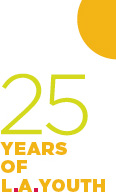Celebrating L.A. Youth’s 25th anniversary: Gay & Lesbian
That’s when it hit me. I wasn’t looking at them as individuals before the conference. In fact, I wasn’t looking at much before this. I characterized people as either gay or straight, like separating whom I could or could not grow close to. I pretended these people weren’t even there, when they definitely were. They were all around me. Listening to these people talk about the isolation from losing friends for being gay made me disappointed … in myself.
From “Opening my mind to gay youth” by Elizabeth Del Cid, North Hollywood HS, January-February 2001
“Look! That guy’s a queer!” One day, a boy tripped me in P.E. My skin ripped as I slid on the concrete, knees first. My P.E. teacher noticed my bleeding knees but I told him I fell by accident. I already had enough people who hated me; the last thing I needed was more people harassing me. Another time, during nutrition, some students called me names and threw pizza at me. I started to cry because I hated myself. I didn’t hate them. They were normal; I couldn’t hate something I envied.
From “Gay and so alone” by Marvin Novelo, 17, Franklin HS, October 2004
Now they are my homeboys. They hang out with us at the bus stops. We show them photos of us and our gay friends. I feel more comfortable knowing that I’m accepted. I do things I wouldn’t do before, like wear a rainbow necklace or bring pictures of myself with my boyfriend.
lllllI used to think they were savages, but now that I’ve gotten to know them, I see that they are different people than they were before. I think they were acting like that because they thought somebody would say that they were gay if they hung out with us.
From “I couldn’t take it anymore” by Trayvione Travis, 18, November-December 2007
As we entered, I was surprised that about half the audience looked nothing like how gay men and women are usually portrayed in the media. There were big, burly men who seemed as straight as rulers, but had their arms around other men’s shoulders. There were women who looked feminine and petite, talking to their girlfriends. Television and movies show gay men as skinny, with feminine accents. They talk like Valley girls, and wear incredibly tight clothes. Lesbians are all butch, large with short hair, maybe a piercing in the nose, or five piercings in both ears. Seeing that a lot of people were like me, not flamboyant, but wearing jeans and T-shirts, and not fitting the stereotypes, I felt more at ease.
From “Proud to be here” by Paul Uhlenkott, 18, Hamilton HS, January-February 2008
|
Looking back over these stories, I was surprised to see that things were so different just a decade ago. In “Opening my mind to gay youth,” the writer wondered why people were gay and was worried that her friends would think she was gay, which she said was worse than being weird. This showed me how things are a lot more open and accepting now. Even though there’s been awesome progress, boys are still bullied in school for being gay or even acting feminine. Just like in “Gay and so alone” and “I couldn’t take it anymore,” there are boys at my school who are called “gay” and “faggot.” I still hear people saying things like, “That’s so gay.” Thankfully, there have never been acts of violence against people who are gay like what the two writers experienced. I was happy when I read “Proud to be here” because the writer finally seemed comfortable with himself. L.A. Youth has published stories about these issues because it makes teens more aware and schools more accepting.
|






